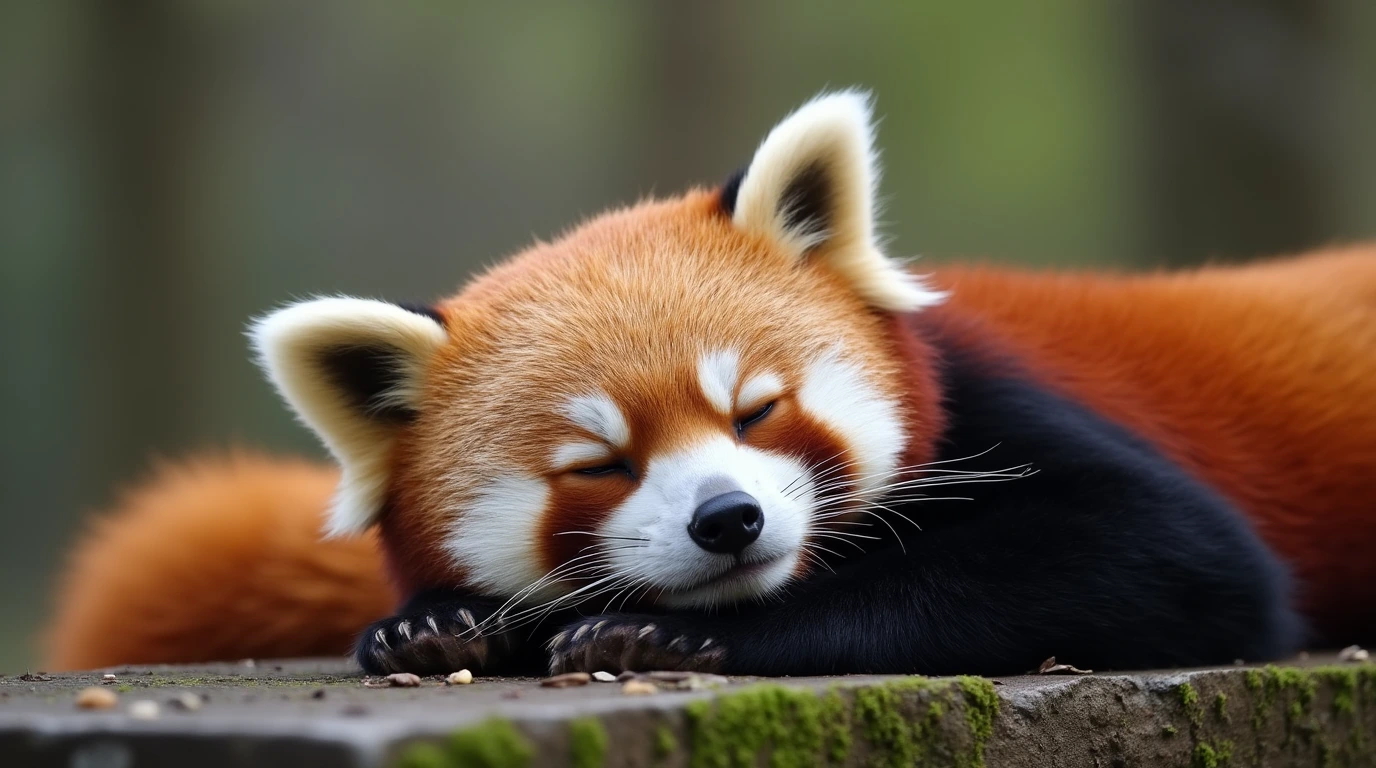Red pandas spend much of their time resting, a behavior that is crucial for their survival. As crepuscular and nocturnal animals, they are most active during dawn and dusk, while the rest of their day is spent sleeping or lounging in trees. Their resting habits are closely linked to their arboreal lifestyle and environmental conditions, as they carefully choose sleeping positions and locations that maximize comfort and safety
In warm weather, red pandas often stretch out along tree branches, letting their legs dangle to cool down. During colder months, they curl up tightly, wrapping their bushy tails around their bodies for warmth. These unique resting behaviors help them regulate body temperature and conserve energy, especially in their mountainous habitats where temperatures can fluctuate significantly
In this article, we will explore where red pandas prefer to rest, how environmental factors influence their sleep habits, and the differences between resting behaviors in the wild and in captivity. Understanding these patterns provides valuable insight into their overall well-being and the adaptations that allow them to thrive in their natural and managed environments
Understanding Red Panda Resting Behaviors

Red pandas are highly adapted to an arboreal lifestyle, spending most of their time resting in trees to stay safe from predators and conserve energy. Their resting patterns are influenced by environmental conditions, temperature, and their natural crepuscular behavior. Unlike many mammals that have fixed sleeping locations, red pandas often switch resting spots depending on factors like weather, food availability, and comfort
Where Red Pandas Prefer to Rest
In the wild, red pandas primarily rest in tree canopies, choosing thick branches or tree hollows as their sleeping spots. These elevated locations offer several advantages: they keep the red panda away from predators such as snow leopards, provide shelter from harsh weather, and allow them to remain hidden within dense foliage. Since red pandas are solitary creatures, they typically rest alone, except during mating season or when a mother is caring for her cubs. They carefully select branches that provide stability and shade, helping them regulate their body temperature while sleeping
In captivity, where natural tree canopies are limited, zookeepers provide elevated wooden platforms and artificial nesting areas to mimic their natural resting environments. These structures help captive red pandas maintain behaviors similar to their wild counterparts, ensuring they feel secure while resting. Many zoos also design enclosures with climbing opportunities, allowing red pandas to choose where they feel most comfortable sleeping throughout the day
How Temperature Influences Red Panda Resting Habits
Red pandas have evolved unique resting behaviors that help them cope with extreme temperature fluctuations in their mountainous habitats. Living at high elevations exposes them to cold winters and warm summers, requiring them to adjust how and where they rest. In warmer conditions, red pandas often stretch out along tree branches, allowing their legs to dangle over the sides
This position promotes airflow around their bodies and helps them release excess heat, preventing overheating. Captive red pandas exhibit similar behaviors by selecting shaded or ventilated areas within their enclosures when temperatures rise
When the weather turns cold, red pandas adopt a different approach to resting. They curl up into a tight ball, tucking their heads beneath their bushy tails for warmth. Their thick fur and long, fluffy tails provide insulation against freezing temperatures, helping them retain body heat in harsh conditions. In extreme cold, they may enter a state similar to torpor, where their metabolism slows down, and they wake periodically to generate warmth through shivering. This natural adaptation allows them to conserve energy while staying warm, an essential survival mechanism in their native environments
Zoos and conservation centers often modify enclosures to accommodate these seasonal behaviors. In regions with hot climates, cooling systems, misting devices, and shaded resting areas help red pandas regulate their body temperature. In colder environments, heated shelters and bedding materials mimic the warmth they would seek in tree hollows or dense vegetation in the wild. By replicating natural temperature variations, captive red pandas can maintain their instinctual resting behaviors without experiencing unnecessary stress
Common Sleeping Positions of Red Pandas
Red pandas exhibit a variety of sleeping postures, each influenced by their surroundings and the climate. One of the most frequently observed resting positions is lying stretched out along a tree branch, with their limbs dangling over the sides. This position is common in warm weather, as it allows air to circulate around their body, helping them cool down. In contrast, colder temperatures bring about a different approach.
Instead of sprawling out, red pandas curl into a compact shape, pressing their bodies tightly together and using their tails as a natural blanket. This posture minimizes heat loss and protects sensitive areas, such as the nose and ears, from the cold
Beyond these temperature-driven postures, red pandas often display a habit of resting their heads on their bushy tails while sleeping. This behavior provides additional comfort and support while they are perched on branches. Even in captivity, where they may rest on platforms rather than trees, they maintain this instinctual behavior
Some individuals prefer to nest in enclosed areas when given the option, while others choose open, elevated spaces that resemble their wild resting sites. The ability to choose where and how they sleep plays a significant role in their overall well-being, reinforcing the importance of maintaining naturalistic environments in zoos and sanctuaries
For more details on red panda sleeping patterns, including how their behavior changes with seasons and temperature shifts, you can explore insights from the Read Panda Network
The Role of the Tail in Red Panda Resting Patterns

Red pandas rely heavily on their bushy tails when resting, using them in different ways depending on their environment and comfort needs. This distinctive feature is more than just an aesthetic characteristic; it plays a vital role in thermoregulation, balance, and overall relaxation. Whether in the wild or captivity, red pandas instinctively incorporate their tails into their resting habits to enhance comfort and security
How Red Pandas Use Their Tails for Comfort and Warmth
One of the most common ways red pandas utilize their tails while resting is by wrapping them around their bodies. This behavior is particularly noticeable in cold weather when temperatures drop, and red pandas need extra insulation to maintain their body heat. Their thick fur provides some protection, but their tail acts as an additional barrier against harsh winds and freezing conditions. By tucking their heads under their tails while curled up, they minimize heat loss, conserving energy during colder months
Beyond its function as a source of warmth, the tail serves as a cushion when red pandas sleep on tree branches. Perched high above the ground, they often rest their heads on their tails for added support, similar to how a human might use a pillow. This posture is common in both wild and captive red pandas, showing that the behavior is deeply ingrained in their instincts. Even when resting in artificial environments, such as zoo enclosures with platforms instead of branches, red pandas continue to use their tails in this manner
Do Red Pandas Sleep in the Same Place Every Day?
Unlike some animals that establish fixed sleeping locations, red pandas tend to change their resting spots frequently. In the wild, their choice of sleeping location depends on environmental factors such as weather, food availability, and safety from predators. Some days they may rest high in the tree canopy, while on colder days, they may seek shelter in a tree hollow or dense foliage for additional warmth. This adaptability allows them to find the most comfortable and secure location for resting based on current conditions
While they do not always sleep in the same tree, red pandas often return to familiar resting sites within their home range. They select spots that provide stability and protection, ensuring they can relax without disturbance. In captivity, red pandas display similar tendencies, often favoring particular platforms, nesting boxes, or shaded areas within their enclosures. However, since they are not exposed to predators or extreme environmental fluctuations, they may show less variation in their resting locations compared to their wild counterparts
How Long Do Red Pandas Sleep Each Day?
Red pandas spend a significant portion of their time resting, with sleep playing a crucial role in their overall well-being. As crepuscular animals, they are most active during dawn and dusk, while the remainder of their day is dedicated to resting and conserving energy. On average, red pandas sleep for approximately 12 to 15 hours per day, although this duration can vary based on factors such as temperature, food availability, and seasonal changes
During particularly hot or cold weather, red pandas may increase their resting time to regulate their body temperature and avoid unnecessary exertion. In the wild, they often adjust their sleep schedules based on external conditions, ensuring they remain comfortable throughout the day. In captivity, where they are provided with stable food sources and climate-controlled environments, their sleep patterns may be more consistent. However, they still maintain their natural crepuscular tendencies, remaining most active in the early morning and late evening
For further insights into how red pandas adapt their resting behavior based on environmental conditions and captivity influences, you can explore research from WWF
Resting Behavior Differences in Wild vs. Captive Red Pandas

Red pandas exhibit distinct differences in their resting behaviors depending on whether they live in the wild or in captivity. While their fundamental habits remain consistent, factors such as environmental conditions, availability of shelter, and human interaction influence how they rest. Understanding these differences provides insight into how red pandas adapt to their surroundings and how zoos and conservation centers can improve their well-being
Do Red Pandas Rest Differently in Zoos?
Red pandas in zoos generally follow the same sleep patterns as their wild counterparts, resting during the day and becoming more active at dawn and dusk. However, some key differences arise due to the controlled environment of captivity. Unlike wild red pandas that must remain alert for predators and forage for food, those in zoos experience fewer external threats and have a consistent food supply. As a result, they may spend more time resting and show fewer interruptions in their sleep cycles
In captivity, red pandas are provided with artificial structures such as wooden platforms, tree branches, and nesting boxes designed to mimic their natural habitat. These elements encourage them to exhibit their instinctive resting behaviors, such as sleeping at elevated heights and using their tails for warmth. However, some red pandas may also take advantage of climate-controlled shelters, an option unavailable to those in the wild. These modifications help maintain their comfort but can sometimes lead to subtle changes in their natural behavior
One significant difference is their response to human activity. In zoos with high visitor traffic, red pandas may experience disturbances that slightly alter their rest patterns. Studies have shown that in enclosures exposed to excessive noise or frequent human presence, red pandas may become more alert and less likely to rest deeply. Some zoos mitigate this by providing secluded areas where red pandas can retreat, ensuring they can rest undisturbed
What Factors Affect the Quality of Rest for Red Pandas?
The quality of a red panda’s rest depends on several environmental and biological factors. Temperature plays a critical role in their ability to sleep comfortably. In the wild, they adjust their sleeping posture based on the season, stretching out in warm weather and curling up tightly in the cold. In captivity, zoos provide temperature-regulated shelters that allow red pandas to maintain their ideal body conditions without the need for extreme behavioral adjustments
Enclosure design also influences sleep quality. In the wild, red pandas have access to a variety of trees and natural hiding spots, enabling them to choose the most secure and comfortable locations for rest. In captivity, enclosures must replicate these conditions as closely as possible by offering sufficient climbing structures and shaded areas. Red pandas housed in enclosures with limited elevation or insufficient shelter may experience increased stress, affecting their ability to rest properly
Human presence and noise levels are additional factors that can impact a red panda’s resting behavior. Wild red pandas typically rest in remote, quiet forested areas with minimal disturbance. In contrast, those in zoos may be exposed to frequent visitor interactions, which can sometimes cause sleep disruptions. Facilities that implement noise barriers or position red panda enclosures in quieter sections of the zoo help create an environment that allows for more natural resting behaviors
Diet and overall health also contribute to sleep quality. A well-balanced diet ensures that red pandas have the necessary energy reserves to maintain their normal activity-rest cycles. Inconsistent feeding schedules or improper nutrition can lead to irregular sleep patterns. Zoos carefully monitor red panda diets, providing a steady supply of bamboo and supplemental nutrients to support their overall well-being
How Human Activity and Noise Influence Red Panda Sleep
Red pandas are sensitive to their surroundings, and human activity can play a role in altering their resting behaviors. In the wild, they inhabit quiet, densely forested regions where they are largely undisturbed. However, habitat destruction and increased human encroachment have led to rising stress levels in some populations. In areas where red pandas come into contact with human settlements, they may experience difficulty finding safe, quiet resting spots, forcing them to adapt their behaviors
In zoos, red pandas are often housed in environments where visitor noise and movement are constant variables. Some red pandas become accustomed to these conditions over time, while others remain sensitive to disturbances. Research has shown that enclosures located near high-traffic areas, such as playgrounds or loud exhibits, can lead to increased alertness and reduced sleep duration in red pandas. Zoos that prioritize enclosure placement in quieter sections report fewer signs of stress-related sleep disruptions
Despite these challenges, well-managed facilities ensure that red pandas receive adequate rest by incorporating naturalistic elements and minimizing unnecessary disturbances. Providing areas with dense vegetation, elevated platforms, and secluded nesting boxes helps replicate their preferred resting conditions. Additionally, structured visitor guidelines, such as limiting noise levels near red panda habitats, contribute to maintaining a stress-free environment
For an in-depth look at red panda behavior, including how environmental factors shape their resting habits, you can explore research from the San Siego Zoo Global Library













